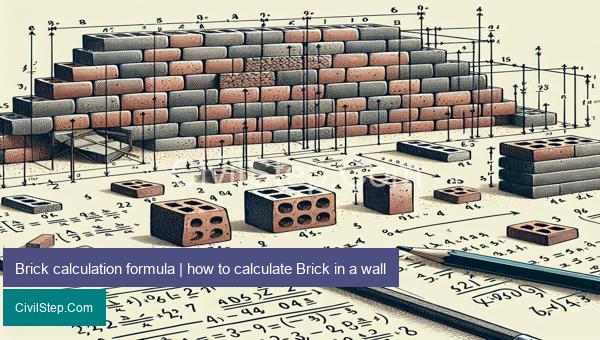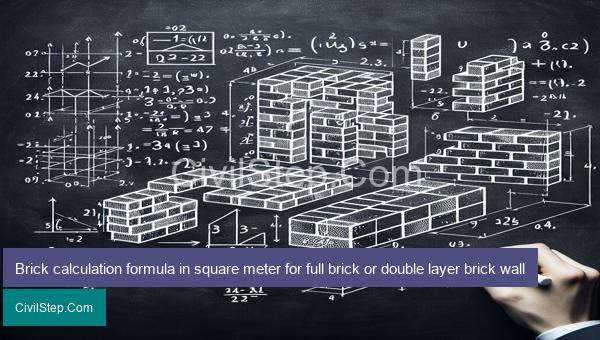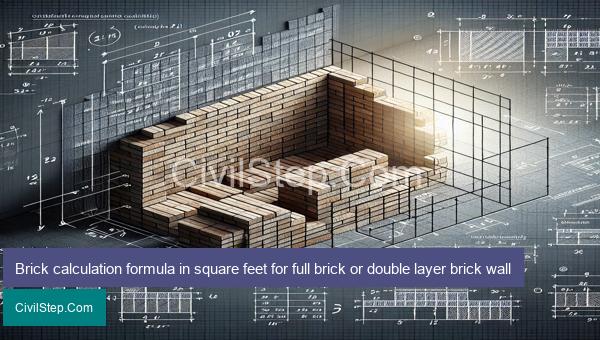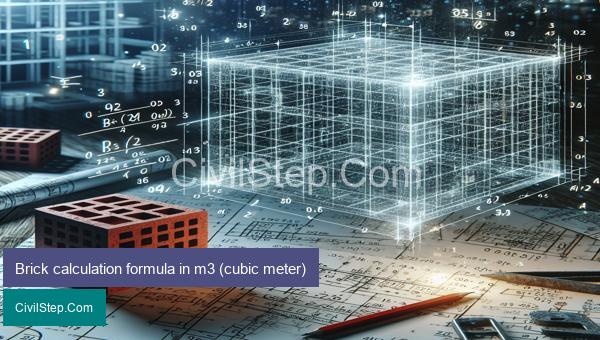
Bricks have been an essential material in construction for thousands of years. From ancient Egyptian pyramids to modern skyscrapers, bricks have stood the test of time as a sturdy and reliable building material. However, determining the necessary quantity of bricks for a project can be a challenging task, especially for beginners in the field of construction. This is where the brick calculation formula comes into play. In this article, we will delve into all about the brick calculation formula, its importance, and how to use it effectively for construction projects. Whether you are a DIY enthusiast or a professional builder, understanding this formula is crucial for accurate and efficient brickwork.
Brick calculation formula | how to calculate Brick in a wall

Bricks are one of the most commonly used building materials in construction. They provide durability, strength, and aesthetic appeal to structures. As a civil engineer, it is important to know how to calculate the quantity of bricks needed for a wall. This calculation is crucial for estimating the cost of materials and ensuring that the correct amount of bricks are ordered for the project. In this article, we will discuss the brick calculation formula and the steps to calculate the number of bricks required for a wall.
Brick Calculation Formula:
The formula for calculating the number of bricks required for a wall is:
Number of Bricks = (Length of Wall / Length of 1 Brick) x (Height of Wall / Height of 1 Brick)
In this formula, the length and height of the wall are measured in the same unit as the length and height of one brick. This formula is used for both single and double walls, and it accounts for the mortar joints between the bricks.
Steps to Calculate Brick in a Wall:
Step 1: Measure the length and height of the wall in the same unit as the length and height of one brick. For example, let’s say the length of the wall is 12 feet (144 inches) and the height is 8 feet (96 inches).
Step 2: Determine the size of the brick. Standard bricks are usually 3 5/8 inches wide, 2 1/4 inches tall, and 8 inches long. The size may vary depending on the region and country.
Step 3: Convert the measurements of the wall and brick into the same unit. In this example, we will convert the measurements to inches as the brick size is also in inches.
Step 4: Use the brick calculation formula. Using the measurements from step 1 and 2, we will have:
Number of Bricks = (144 inches / 8 inches) x (96 inches / 2 1/4 inches)
= 18 x 42.67
= 767.86
So, we will need approximately 767 bricks for this wall.
Step 5: Account for the mortar joints. The brick calculation formula only accounts for the bricks and does not consider the mortar joints between them. It is recommended to add 5% to 10% to the total number of bricks to account for the mortar joints. In this example, we will multiply 767 by 1.05 to add 5% and get a total of 805 bricks.
Step 6: Consider the type of brick bond. The brick bond refers to the pattern in which the bricks are laid. This can impact the number of bricks required for the wall. For example, a common brick bond is the stretcher bond which requires a half brick at the end of each row, resulting in more bricks needed. It is important to consider the type of bond and adjust the number of bricks accordingly.
Step 7: Round up to the nearest full number. Bricks are usually sold in full numbers, so it is important to round up the calculated number to the nearest full number. In this example, we will need 806 bricks for the wall.
Step 8: Consider waste or breakage. It is also recommended to add 5% to the total number of bricks to account for any waste or breakage during construction.
In conclusion, calculating the number of bricks required for a wall is a simple process that requires accurate measurements and the use of
Brick calculation formula and how to calculate Brick in a wall

Brick calculation formula is a vital aspect of construction planning for any civil engineer. It allows engineers to accurately estimate the amount of bricks needed for a project, thus ensuring efficient use of materials and budget. The calculation for brick quantities can vary slightly depending on the type of wall being constructed, but the following basic formula applies for most scenarios:
Number of bricks = (Wall area / Brick area) * (1 + Waste percentage)
Here, Wall area refers to the total surface area of the wall in square feet or square meters. Brick area is the area covered by one brick, which includes the mortar joints. This area is calculated by multiplying the length and width of a brick. The waste percentage is typically considered between 5-10% to account for broken or damaged bricks and mortar.
For example, let’s say we need to calculate the number of bricks for a wall with an area of 500 square feet and a standard brick size of 8 inches by 4 inches.
Brick area = 8 inches * 4 inches = 32 square inches = 0.22 square feet
Number of bricks = (500 square feet / 0.22 square feet) * (1 + 0.05) = 5727 bricks
This is the basic formula for calculating the number of bricks needed for a wall. However, there are a few variations depending on the type of wall and the brick laying pattern. For instance, for a single brick wall without a cavity, the thickness of the wall needs to be considered in the calculation. In this case, the formula would be:
Number of bricks = (Wall area / (Brick length * Brick height)) * (1 + Waste percentage)
Similarly, for a cavity wall, where two layers of bricks are used, the calculation would be:
Number of bricks = (Wall area / (2 * Brick length * Brick height)) * (1 + Waste percentage)
For a wall with a different brick laying pattern, such as stretcher bond or Flemish bond, the formula would be modified accordingly. In these patterns, the length and height of a brick may vary, so it is important to consider the correct measurements while calculating.
Apart from calculating the number of bricks, civil engineers also need to determine the amount of mortar needed for the wall. This can be done by multiplying the number of bricks by the mortar joint thickness, which is typically around 10-12mm.
In conclusion, brick calculation formula is an essential tool for civil engineers in construction planning. It helps them to accurately estimate the number of bricks and mortar required for a wall, ensuring efficient use of materials and cost-effective construction.
Brick calculation formula in square meter for half brick or singular layer brick wall

A brick calculation formula in square meter, also known as a brickwork calculator, is a useful tool for determining the amount of bricks needed for a particular construction project. This calculation is especially important for brick walls, as they are one of the most commonly used building materials in civil engineering.
When it comes to brick walls, there are various types of bricks that can be used, such as full brick, half brick, and singular layer brick. Each type has its own unique calculation formula for determining the required number of bricks per square meter. In this article, we will focus on the formula for half brick and singular layer brick walls.
Half Brick Wall Formula:
A half brick wall, also known as a single brick wall, is a wall constructed using bricks that are halved lengthwise. This type of wall is commonly used for non-load bearing walls or as an outer skin in a cavity wall. To calculate the number of bricks needed for a half brick wall, the following formula can be used:
Number of bricks = (Length of wall in meters x Height of wall in meters) / (Width of brick in meters x Thickness of brick in meters)
Singular Layer Brick Wall Formula:
A singular layer brick wall is a wall constructed using bricks stacked on top of each other in a single layer. This type of wall is often used for load-bearing walls as it provides more structural stability. The formula for calculating the number of bricks needed for a singular layer brick wall is as follows:
Number of bricks = (Length of wall in meters x Height of wall in meters) / (Length of brick in meters x Height of brick in meters)
Additional Factors to Consider:
There are a few other factors that need to be taken into consideration when calculating the number of bricks needed for a wall. These include the mortar joint thickness, wastage due to cutting, and overlaps at corners and openings. It is important to account for these factors in the calculation to ensure accurate estimation of the required number of bricks.
In conclusion, brick calculation in square meter is an essential process in civil engineering for determining the exact number of bricks needed for a construction project. By using the appropriate formula for half brick or singular layer brick walls and considering additional factors, civil engineers can accurately estimate the required amount of bricks, ensuring a successful and efficient construction process.
Brick calculation formula in square meter for full brick or double layer brick wall

Brick calculation is an important aspect in the construction process. It helps engineers determine the number of bricks required for a particular project, which in turn helps in accurate budgeting and planning. In this article, we will discuss the formula for calculating the number of bricks needed in a square meter for a full brick or double layer brick wall.
Full Brick Wall:
A full brick wall refers to a wall where only one layer of bricks is used. Here is the formula for calculating the number of bricks needed in a square meter for a full brick wall:
Number of bricks = (Length of wall x height of wall)/ (length of one brick x height of one brick)
For example, let’s say the wall length is 10 meters and height is 2.5 meters. The size of one brick is 0.22 meters in length and 0.11 meters in height. Putting these values in the formula, we get:
Number of bricks = (10 x 2.5)/(0.22 x 0.11)
= 1136.36 bricks
Therefore, for a full brick wall, you will need 1136.36 bricks per square meter.
Double Layer Brick Wall:
A double layer brick wall refers to a wall where two layers of bricks are used with a gap of about 1.5-2 cm between them. The formula for calculating the number of bricks needed in a square meter for a double layer brick wall is:
Number of bricks = {(Length of wall x height of wall) – (Area of openings)}/ (length of one brick x height of one brick)
In this formula, we deduct the area of openings such as doors and windows as they do not require bricks. Let’s understand this with an example.
Let’s say the wall length is 10 meters, height is 2.5 meters, and there is one door present with an area of 2 meters in length and 1.5 meters in height. Considering the size of one brick to be 0.22 meters in length and 0.11 meters in height, the formula will be:
Number of bricks = {(10 x 2.5) – (2 x 1.5)}/(0.22 x 0.11)
= 883.37 bricks
Therefore, for a double layer brick wall, you will need 883.37 bricks per square meter.
Conclusion:
It is essential to calculate the number of bricks required accurately to avoid any shortage or wastage of bricks during construction. The brick calculation formula in square meter for a full brick or double layer brick wall as mentioned above can help in achieving this goal. It is also vital to consider the additional bricks needed for corners and pillars, and to add a few extra bricks to the final count as a buffer for any errors or breakages. This will ensure that the construction process goes smoothly without any delays or cost overruns.
Brick calculation formula in square feet for half brick or singular layer brick wall

When building a brick wall, it is important to calculate the number of bricks needed accurately to prevent delays and potential costly mistakes. The following formula can be used to determine the number of bricks needed for a square foot of half brick or singular layer brick wall:
Number of bricks = (Area of wall in square feet / Area of one brick in square feet) * 2
The first step is to measure the area of the wall in square feet. This can be done by multiplying the length and height of the wall. For example, if the wall is 10 feet long and 8 feet high, the area would be 80 square feet.
The next step is to determine the area of one brick in square feet. This can be calculated by multiplying the length and width of the brick. For half bricks, the length is usually halved while the width remains the same. For example, if the full brick size is 8 inches by 4 inches, the half brick size would be 4 inches by 4 inches. This would result in an area of 0.22 square feet (4 inches = 0.33 feet).
Now, using the formula, we can calculate the number of bricks needed for the wall. Using the example from above, we would have:
Number of bricks = (80 square feet / 0.22 square feet) * 2
= 728.2 * 2
= 1456.4 bricks
However, it is important to note that this calculation does not take into account any waste or breakage of bricks. It is recommended to add an additional 5-10% to the final number to account for this.
In conclusion, the formula for calculating the number of bricks needed for a square foot of half brick or singular layer brick wall is:
(Number of bricks = (Area of wall in square feet / Area of one brick in square feet) * 2) + (5% – 10% of the result for waste or breakage)
Brick calculation formula in square feet for full brick or double layer brick wall

Brick calculation is an important part of civil engineering and construction as it helps in estimating the quantity and cost of bricks needed for a particular project. The calculation of bricks for a full brick or double layer brick wall is based on the total area of the wall to be constructed.
The formula for calculating the number of bricks required for a full brick wall in square feet is:
Number of bricks = (Wall area in square feet) / (Brick area in square feet)
The standard size of a brick is 9 inches by 4.5 inches, which is equivalent to 0.75 feet by 0.375 feet. Therefore, the area of one brick is 0.75 x 0.375 = 0.28125 square feet.
For example, if the wall area to be constructed is 200 square feet, then the number of bricks required would be:
Number of bricks = (200) / (0.28125)
= 711.11 bricks
This calculation only gives an estimate and does not account for wastage or the space required for mortar. To account for wastage, it is recommended to add an additional 5-10% to the total number of bricks required.
In the case of a double layer brick wall, the formula is slightly different as it takes into account the thickness of the wall. The formula for calculating the number of bricks required for a double layer brick wall in square feet is:
Number of bricks = (Wall area in square feet) / ((Brick height in feet) x (Brick length in feet))
The standard thickness of a double brick wall is 9 inches, which is equal to 0.75 feet. Therefore, the brick height in the formula would be 0.75 feet.
Using the same example as before, if the wall area to be constructed is 200 square feet, the number of bricks required for a double layer brick wall would be:
Number of bricks = (200) / (0.75 x 0.375)
= 711.11 x 2 = 1422.22 bricks
Again, it is important to add an extra 5-10% for wastage.
In conclusion, brick calculation is a simple formula that can help estimate the number of bricks required for a full brick or double layer brick wall. It is important to keep in mind that this is just an estimate and factors like wastage and mortar should be considered for a more accurate estimation.
Brick calculation formula in CFT (cubic feet)

Brick calculation is an important aspect in the construction industry as it helps in determining the quantity of bricks required for a project. There are various units in which brick calculation can be done, such as number of bricks, number of cubic meters or cubic feet. Here, we will discuss the formula for brick calculation in cubic feet (CFT).
Before we dive into the formula, it is important to understand what a cubic feet (CFT) is. One cubic feet is equivalent to the volume of a cube with sides measuring 1 feet in length. CFT is commonly used in the construction industry as a unit of measurement for materials such as bricks, concrete, and sand.
Formula for Brick Calculation in CFT:
The formula for brick calculation in cubic feet (CFT) is:
Number of bricks = (Cement thickness in inches x Cement height in inches x Cement length in inches)/144
In this formula, we are multiplying the dimensions of the brick in inches and then dividing it by 144 to convert it into cubic feet. The number 144 represents the number of square inches in one square feet. The dimensions used in this formula are as follows:
1. Cement thickness: This refers to the thickness of the brick, which is usually 3.75 inches.
2. Cement height: This is the height of the brick, which is generally 2.25-3 inches.
3. Cement length: This is the length of the brick, which can vary depending on the type of brick used. For example, the standard length of a modular brick is 7.625 inches.
Once we have these dimensions, we can plug them into the formula and calculate the number of bricks required in cubic feet. Let’s take an example to understand this better.
Example:
Let’s say we want to calculate the number of bricks required for a wall that is 10 feet high, 20 feet long, and 3.75 inches thick.
Number of bricks = (3.75 x 10 x 20)/144
= 750/144
= 5.20 cubic feet
This means that 5.20 cubic feet of bricks will be required to build this wall.
In conclusion, brick calculation in CFT is an easy and efficient way to determine the quantity of bricks required for a project. This formula can be used for any type of brick, as long as the dimensions are known. It is important to remember to use the same unit of measurement for all dimensions to get an accurate result.
Brick calculation formula in m3 (cubic meter)

As a civil engineer, it is crucial to understand how to calculate the quantity of bricks required for a construction project. This knowledge is essential in determining the cost and estimating the total time needed for a project.
The most common unit used for brick calculation is the cubic meter (m3). This is because it is a standard unit of measurement for construction material and can be easily converted into other units, such as square feet or square meters.
The formula for calculating the number of bricks in cubic meters is as follows:
Number of bricks (m3) = Volume of masonry (m3) / Volume of One Brick (m3)
To understand this formula, we first need to break it down into its components.
1. Volume of Masonry (m3):
The volume of masonry refers to the total volume or size of the brickwork. It is calculated by multiplying the length, width, and height of the wall or structure in meters. The formula for calculating the volume of masonry is:
Volume of Masonry (m3) = Length (m) x Width (m) x Height (m)
2. Volume of One Brick (m3):
The volume of one brick refers to the space occupied by a single brick. It is calculated by multiplying the length, width, and height of the brick in meters. The formula for calculating the volume of one brick is:
Volume of One Brick (m3) = (Length of Brick (m) x Width of Brick (m) x Height of Brick (m)
Once we have these two values, we can easily calculate the number of bricks (m3) required for a construction project.
For example, if we have a wall with a length of 10 meters, a width of 5 meters, and a height of 3 meters, and the size of a single brick is 0.2 meters in length, 0.1 meters in width, and 0.07 meters in height, the calculations would be as follows:
1. Volume of Masonry (m3) = Length (m) x Width (m) x Height (m)
= 10m x 5m x 3m
= 150 m3
2. Volume of One Brick (m3) = (Length of Brick (m) x Width of Brick (m) x Height of Brick (m)
=0.2m x 0.1m x 0.07m
= 0.0014 m3
Number of bricks (m3) = Volume of masonry (m3) / Volume of One Brick (m3)
= 150 m3 / 0.0014m3
= 107,142.85 bricks (m3)
Therefore, 107,142.85 bricks (m3) would be required for constructing a wall with the given dimensions.
In conclusion, calculating the number of bricks in cubic meters is a straightforward process that can help architects and engineers accurately estimate the quantity of bricks needed for a construction project. This formula is not only essential for cost estimation but also plays a crucial role in ensuring the success and timely completion of a project.
Conclusion
In conclusion, understanding the brick calculation formula is essential for accurately estimating the number of bricks needed for a construction project. By following the steps outlined in this article, individuals can confidently calculate the required bricks and avoid over or underestimating, ultimately saving time and money. It is crucial to keep in mind the different types of bricks and their dimensions, as well as any necessary adjustments for wastage. Furthermore, with the help of online calculators or software, the brick calculation process can be made even more efficient and accurate. With a thorough understanding of the brick calculation formula, builders and contractors can ensure smooth and successful construction projects.
